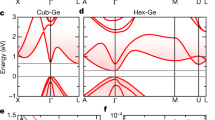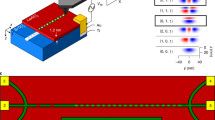Abstract
The epitaxial growth of germanium on silicon leads to the self-assembly of SiGe nanocrystals by a process that allows the size, composition and position of the nanocrystals to be controlled. This level of control, combined with an inherent compatibility with silicon technology, could prove useful in nanoelectronic applications. Here, we report the confinement of holes in quantum-dot devices made by directly contacting individual SiGe nanocrystals with aluminium electrodes, and the production of hybrid superconductor–semiconductor devices, such as resonant supercurrent transistors, when the quantum dot is strongly coupled to the electrodes. Charge transport measurements on weakly coupled quantum dots reveal discrete energy spectra, with the confined hole states displaying anisotropic gyromagnetic factors and strong spin–orbit coupling with pronounced dependences on gate voltage and magnetic field.
This is a preview of subscription content, access via your institution
Access options
Subscribe to this journal
Receive 12 print issues and online access
$259.00 per year
only $21.58 per issue
Buy this article
- Purchase on Springer Link
- Instant access to full article PDF
Prices may be subject to local taxes which are calculated during checkout





Similar content being viewed by others
References
Javey, A., Guo, J., Wang, Q., Lundstrom, M. & Dai, H. J. Ballistic carbon nanotube field-effect transistors. Nature 424, 654–657 (2003).
Xiang, J. et al. Ge/Si nanowire heterostructures as high-performance field-effect transistors. Nature 441, 489–493 (2006).
Ryu, K. et al. CMOS-analogous wafer-scale nanotube-on-insulator approach for submicrometer devices and integrated circuits using aligned nanotubes. Nano Lett. 9, 189–197 (2009).
Nam, S. W., Jiang, X., Xiong, Q., Ham, D. & Lieber C. M. Vertically integrated, three-dimensional complementary metal-oxide–semiconductor circuits. Proc. Natl Acad. Sci. USA 106, 21035–21038 (2009).
Eaglesham, D. J. & Cerullo, M. Dislocation-free Stranski–Krastanow growth of Ge on Si(100). Phys. Rev. Lett. 64, 1943–1946 (1990).
Mo, Y. W., Savage, D. E., Swartzenruber, B. S. & Lagally M. G. Kinetic pathway in Stranski–Krastanov growth of Ge on Si(001). Phys. Rev. Lett. 65, 1020–1023 (1990).
Medeiros-Ribeiro, G. et al. Shape transition of germanium nanocrystals on a silicon (001) surface from pyramids to domes. Science 279, 353–355 (1998).
Stangl, J., Holý, V. & Bauer, G. Structural properties of self-organized semiconductor nanostructures. Rev. Mod. Phys. 76, 725–783 (2004).
Katsaros, G. et al. Kinetic origin of island intermixing during the growth of Ge on Si(001). Phys. Rev. B 72, 195320 (2005).
Schmidt, O. G. (ed.). Lateral Alignment of Epitaxial Quantum Dots (Springer, 2007).
Katsaros, G. et al. Positioning of strained islands by interaction with surface nanogrooves. Phys. Rev. Lett. 101, 096103 (2008).
Schmidt, O. G. & Eberl, K. Self-assembled Ge/Si dots for faster field effect transistors. IEEE Trans. Electron Dev. 48, 1175–1179 (2001).
Xiang, J., Vidan, A., Tinkham, M., Westervelt, R. M. & Lieber C. M. Ge/Si nanowire mesoscopic Josephson junctions. Nature Nanotech. 1, 208–213 (2006).
Hu, Y. A Ge/Si heterostructure nanowire-based double quantum dot with integrated charge sensor. Nature Nanotech. 2, 622–625 (2007).
Shaji, N. et al. Spin blockade and lifetime-enhanced transport in a few-electron Si/SiGe double quantum dot. Nature Phys. 4, 540–544 (2008).
Simmons, C. B. et al. Charge sensing and controllable tunnel coupling in a Si/SiGe double quantum dot. Nano Lett. 9, 3234–3238 (2009).
Hayes, R. R. et al. Lifetime measurements (T1) of electron spins in Si/SiGe quantum dots. Preprint at http://arxiv.org/abs/0908.0173 (2009).
Dötsch, U. et al. Single-hole transistor in p-Si/SiGe quantum well. Appl. Phys. Lett. 78, 341–343 (2001).
Petta, J. R. & Ralph, D. C. Studies of spin–orbit scattering in noble-metal nanoparticles using energy-level tunneling spectroscopy. Phys. Rev. Lett. 87, 266801 (2001).
Winkler, R. Spin–Orbit Coupling Effect in Two-Dimensional Electron and Hole Systems (Springer, 2004).
Csonka, S. et al. Giant fluctuations and gate control of the g-factor in InAs nanowire quantum dots. Nano Lett. 8, 3932–3935 (2008).
Nilson, H. A. et al. Giant, level-dependent g factors in InSb nanowire quantum dots. Nano Lett. 9, 3151–3156 (2009).
Salis, G. et al. Electrical control of spin coherence in semiconductor nanostructures. Nature 414, 619–622 (2001).
Roddaro, S. et al. Spin states of holes in Ge/Si nanowire quantum dots. Phys. Rev. Lett. 101, 186802 (2008).
Jung, M. et al. Lateral electron transport through single self-assembled InAs quantum dots. Appl. Phys. Lett. 86, 033106 (2005).
Hamaya, K. et al. Kondo effect in a semiconductor quantum dot coupled to ferromagnetic electrodes. Appl. Phys. Lett. 91, 232105 (2007).
Buizert, C., Oiwa, A., Shibata, K., Hirakawa, K. & Tarucha, S. Kondo universal scaling for a quantum dot coupled to superconducting leads. Phys. Rev. Lett. 99, 136806 (2007).
Glazman, L. I. & Matveev, K. A. Resonant Josephson current through Kondo impurities in a tunnel barrier. JETP Lett. 49, 659–662 (1989).
Beenakker, C. W. J. & van Houten, H. Resonant Josephson current through a quantum dot, in Single-Electron Tunneling and Mesoscopic Devices (eds Koch, H. & Lübbig, H.) 175–179 (Springer, 1992), http://arxiv.org/abs/cond-mat/0111505.
Jarillo-Herrero, P., van Dam, J. A. & Kouwenhoven, L. P. Quantum supercurrent transistors in carbon nanotubes. Nature 439, 953–956 (2006).
Cleuziou, J.-P., Wernsdorfer, W., Bouchiat, V., Ondarçuhu, T. & Monthioux, M. Carbon nanotube superconducting quantum interference device. Nature Nanotech. 1, 53–59 (2006).
van Dam, J. A., Nazarov, Y. V., Bakkers, E. P. A. M., De Franceschi, S. & Kouwenhoven, L. P. Supercurrent reversal in quantum dots. Nature 442, 667–670 (2006).
Winkelmann, C. B., Roch, N., Wernsdorfer, W. Bouchiat, V. & Balestro, F. Superconductivity in a single-C60 transistor. Nature Phys. 5, 876–879 (2009).
Nenashev, A. V., Dvurechenskii, A. V. & Zinovieva, A. F. Wave functions and g factor of holes in Ge/Si quantum dots. Phys. Rev. B 67, 205301 (2003).
Hensel, J. C. & Suzuki, K. Anisotropy of g factor of free hole in Ge and conduction-band spin–orbit splitting. Phys. Rev. Lett. 22, 838–840 (1969).
Haendel, K.-M., Winkler, R., Denker, U., Schmidt, O. G. & Haug, R. J. Giant anisotropy of Zeeman splitting of quantum confined acceptors in Si/Ge. Phys. Rev. Lett. 96, 086403 (2006).
De Franceschi, S. et al. Electron cotunneling in a semiconductor quantum dot. Phys. Rev. Lett. 86, 878–881 (2001).
Buitelaar, M. R. et al. Multiple Andreev reflections in a carbon nanotube quantum dot. Phys. Rev. Lett. 91, 057005 (2003).
Hanson, R., Kouwenhoven, L. P., Petta, J. R., Tarucha, S. & Vandersypen, L. M. K. Spins in few-electron quantum dots. Rev. Mod. Phys. 79, 1217–1265 (2007).
Nitta, J., Akazaki, T., Takayanagi, H. & Enoki, T. Gate control of spin–orbit interaction in an inverted In0.53Ga0.47As/In0.52Al0.48As heterostructure. Phys. Rev. Lett. 78, 1335–1338 (1997).
Golovach, V. N., Borhani, M. & Loss, D. Electric-dipole-induced spin resonance in quantum dots. Phys. Rev. B 74, 165319 (2006).
Nowack, K. C., Koppens, F. H. L., Nazarov, Yu. V. & Vandersypen, L. M. K. Coherent control of a single electron spin with electric fields. Science 318, 1430–1433 (2007).
Frolov, S. M. et al. Ballistic spin resonance. Nature 458, 868–871 (2009).
Fasth, C., Fuhrer, A., Samuelson, L., Golovach, V. N. & Loss, D. Direct measurement of the spin–orbit interaction in a two-electron InAs nanowire quantum dot. Phys. Rev. Lett. 98, 266801 (2007).
Roch, N., Florens, S., Bouchiat, V., Wernsdorfer, W. & Balestro, F. Quantum phase transition in a single-molecule quantum dot. Nature 453, 633–638 (2008).
Golovach, V. N., Khaetskii, A. & Loss, D. Spin relaxation at the singlet–triplet crossing in a quantum dot. Phys. Rev. B 77, 045328 (2008).
Takahashi, S. et al. Large anisotropy of spin–orbit interaction in a single InAs self-assembled quantum dot. Preprint at http://arxiv.org/abs/0912.3088 (2009).
Pasupathy, A. N. et al. The Kondo effect in the presence of ferromagnetism. Science 306, 86–89 (2004).
Hauptmann, J. R., Paaske, J. & Lindelof P. E. Electric-field-controlled spin reversal in a quantum dot with ferromagnetic contacts. Nature Phys. 4, 373–376 (2008).
Zazunov, A., Egger, R., Jonckheere, T. & Martin, T. Anomalous Josephson current through a spin–orbit coupled quantum dot. Phys. Rev. Lett. 103, 147004 (2009).
Acknowledgements
The authors thank T. Haccart and the PTA cleanroom team of CEA, J.-L. Thomassin and F. Gustavo for their help in device fabrication, and T. Fournier for helpful discussions and providing free access to fabrication recipes and equipment at the NANOFAB facility of the Néel Institute. We also acknowledge helpful discussions with M. Houzet, V. Golovach, W. Wernsdorfer, D. Feinberg, G. Usaj, R. Whitney, M. Sanquer, X. Jehl, G. A. Steele and E. J. H. Lee, and support from the Agence Nationale de la Recherche (through the ACCESS and COHESION projects). G.K. acknowledges further support from the Deutsche Forschungsgemeinschaft (grant no. KA 2922/1-1).
Author information
Authors and Affiliations
Contributions
G.K. and S.D.F. planned the experiment, interpreted the data and co-wrote the paper. G.K. fabricated the devices, performed the measurements with P.S. and S.D.F., and analysed the data. P.S. participated in the data analysis and set up the dilution refrigerator. M.S. grew the SiGe self-assembled nanocrystal samples. F.F. fabricated the non-standard SOI wafers. M.M., V.B. and F.L. provided important help in device fabrication. A.R. and O.G.S. supervised the growth of the self-assembled SiGe nanocrystals. All authors discussed the results and commented on the manuscript.
Corresponding authors
Ethics declarations
Competing interests
The authors declare no competing financial interests.
Supplementary information
Supplementary information
Supplementary information (PDF 481 kb)
Rights and permissions
About this article
Cite this article
Katsaros, G., Spathis, P., Stoffel, M. et al. Hybrid superconductor–semiconductor devices made from self-assembled SiGe nanocrystals on silicon. Nature Nanotech 5, 458–464 (2010). https://doi.org/10.1038/nnano.2010.84
Received:
Accepted:
Published:
Issue Date:
DOI: https://doi.org/10.1038/nnano.2010.84
This article is cited by
-
Parity-conserving Cooper-pair transport and ideal superconducting diode in planar germanium
Nature Communications (2024)
-
The germanium quantum information route
Nature Reviews Materials (2020)
-
Primary growth of binary nanoparticle superlattices with distinct systems contingent on synergy: softness and crystalline anisotropy
Applied Nanoscience (2020)
-
A germanium hole spin qubit
Nature Communications (2018)
-
Single-electron charge sensing in self-assembled quantum dots
Scientific Reports (2018)



